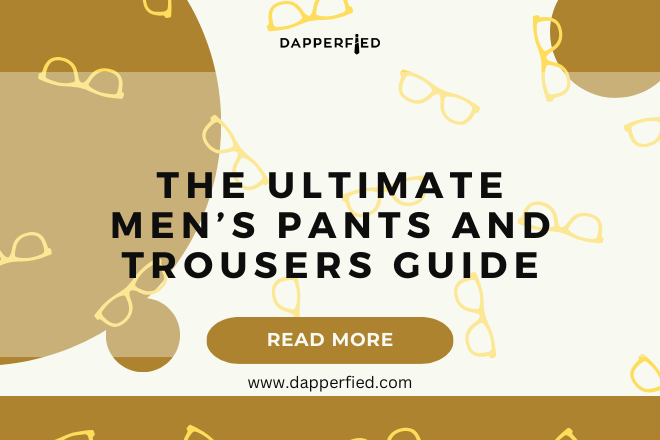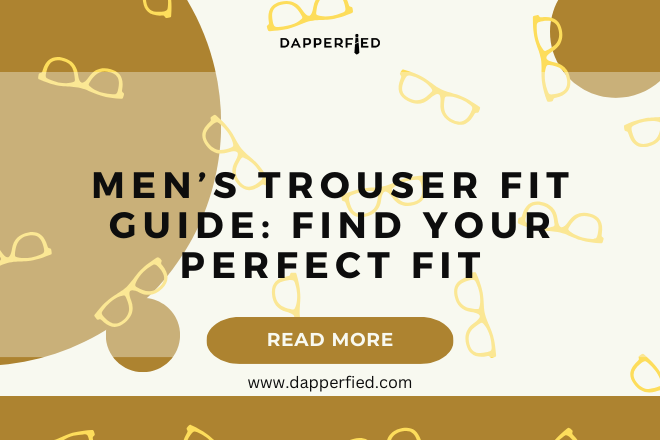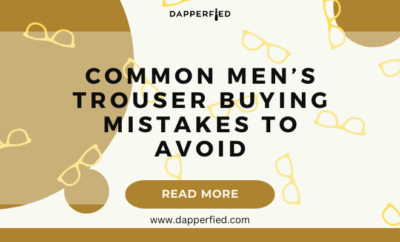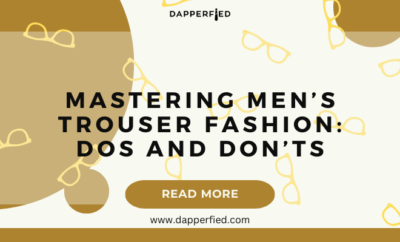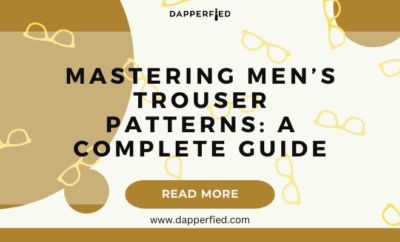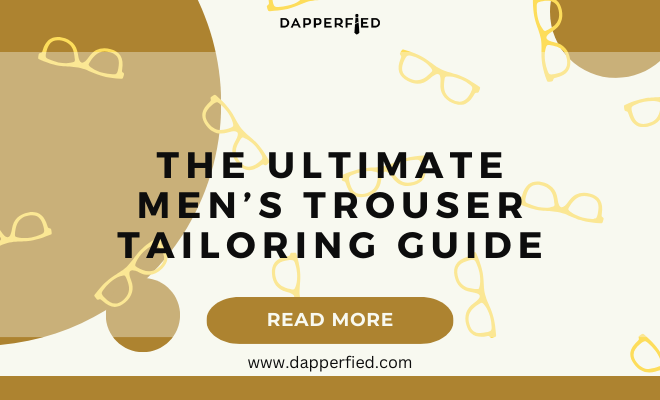
Men's Style
The Ultimate Men’s Trouser Tailoring Guide
When it comes to choosing the right fabric for your trousers, there are a few key factors to consider. First and foremost, you’ll want to think about the season and climate in which you’ll be wearing the trousers. For warmer weather, lightweight and breathable fabrics like cotton, linen, or chambray are ideal choices. These fabrics will help keep you cool and comfortable throughout the day. On the other hand, for colder weather, you may want to opt for heavier fabrics like wool or corduroy, which will provide warmth and insulation.
Another important consideration when choosing fabric is the level of formality you’re aiming for. For a more casual look, denim or twill can be great options, while for a more formal or professional look, wool or wool-blend fabrics are often preferred. Additionally, consider the drape and structure of the fabric. Some fabrics have more drape and flow, while others are more structured and hold their shape. The drape of the fabric can affect the overall look and feel of the trousers, so it’s important to choose a fabric that aligns with your desired aesthetic.
Key Takeaways
- Choose fabric based on the occasion and climate
- Understand the different styles and fits to find the most flattering option
- Take accurate measurements to ensure the perfect fit
- Select the perfect waistband for comfort and style
- Master the art of hemming for a polished look
- Add finishing touches like buttons and pockets for a personalized touch
- Care for your trousers by following the specific care instructions for the fabric
Understanding Different Styles and Fits
When it comes to trousers, there are a variety of styles and fits to choose from, each offering a unique look and feel. One of the most popular styles is the classic straight leg, which offers a timeless and versatile silhouette that works well for both casual and formal occasions. Another popular option is the slim fit, which offers a more tailored and modern look. Slim fit trousers are often favored for their sleek and stylish appearance.
For those looking for a more relaxed and comfortable fit, a wide leg or relaxed fit trouser may be the way to go. These styles offer a looser fit through the leg, providing ample room for movement and a laid-back vibe. Additionally, there are also options like bootcut or flared trousers, which offer a more dramatic silhouette with a wider leg opening. Understanding the different styles and fits available will help you choose the perfect pair of trousers that align with your personal style and preferences.
Taking Accurate Measurements
Taking accurate measurements is crucial when it comes to ensuring the perfect fit for your trousers. To start, you’ll want to measure your waist at the narrowest point, typically around your natural waistline. It’s important to measure without holding your breath or sucking in your stomach, as this can result in an inaccurate measurement. Next, measure your hips at the widest point, ensuring that the measuring tape is parallel to the floor for an accurate measurement.
In addition to waist and hip measurements, it’s also important to measure your inseam, which is the distance from your crotch to the bottom of your ankle. This measurement will help determine the length of your trousers. Finally, consider taking measurements for thigh circumference and knee circumference if you’re opting for a tailored or custom fit. Taking accurate measurements will ensure that your trousers fit comfortably and flatteringly, allowing you to move with ease and confidence.
Selecting the Perfect Waistband
| Waistband Type | Comfort Level | Support Level | Flexibility |
|---|---|---|---|
| Elastic | High | Medium | High |
| Drawstring | Medium | High | Medium |
| Belted | High | High | Low |
The waistband is a crucial component of any pair of trousers, as it plays a significant role in both comfort and fit. When selecting the perfect waistband, consider factors such as width, closure, and flexibility. A wider waistband can provide additional support and comfort, particularly for those with a larger waist size. On the other hand, a narrower waistband can create a sleek and streamlined look, ideal for those seeking a more tailored appearance.
In terms of closure, there are various options to choose from, including buttons, hooks, zippers, or even elastic waistbands. Each closure type offers its own set of benefits and considerations. For example, buttons and hooks provide a secure closure but may require more effort to fasten, while zippers offer convenience but may be less flexible in terms of fit. Elastic waistbands can provide added comfort and flexibility, making them a popular choice for casual or athleisure trousers.
Mastering the Art of Hemming
Hemming is an essential step in tailoring trousers to achieve the perfect length. Whether you’re hemming trousers yourself or taking them to a tailor, it’s important to understand the different hemming techniques available. One common method is a plain hem, where the fabric is folded up once and stitched in place. This creates a clean and simple finish that works well for most fabrics and styles.
Another popular hemming technique is a blind hem, which involves folding the fabric in such a way that the stitching is nearly invisible from the outside. This technique is often used for more formal or dressy trousers where a seamless finish is desired. Additionally, there are options like cuffed hems or rolled hems, which add a touch of style and personality to the trousers. Mastering the art of hemming will ensure that your trousers are tailored to perfection, creating a polished and professional look.
Adding Finishing Touches

Adding finishing touches to your trousers can elevate their overall look and feel. Consider details like pockets, pleats, cuffs, or belt loops to customize your trousers to your liking. Pockets not only add functionality but also contribute to the aesthetic of the trousers. Side pockets offer convenience and a streamlined look, while back pockets can add visual interest and balance to the design.
Pleats are another detail that can enhance the style of trousers. While some may prefer flat-front trousers for a sleek and modern look, pleats can add depth and sophistication to the design. Additionally, consider adding cuffs to your trousers for a classic touch. Cuffs not only add weight to the bottom of the trousers for a clean drape but also offer a timeless and refined look. Finally, belt loops provide practicality and allow you to accessorize with belts for added style.
Caring for Your Trousers
Caring for your trousers is essential in maintaining their quality and longevity. Always check the care label on your trousers for specific instructions regarding washing and drying. In general, it’s best to wash trousers inside out in cold water to preserve their color and fabric integrity. Avoid using harsh detergents or bleach that can damage the fabric.
When it comes to drying your trousers, air drying is often recommended to prevent shrinkage or damage from high heat. If using a dryer, opt for a low heat setting and remove the trousers promptly to prevent wrinkles or creases. Additionally, consider investing in a steamer or iron to keep your trousers looking crisp and wrinkle-free. Proper care for your trousers will ensure that they maintain their shape, color, and overall appearance for years to come.

If you’re looking to complete your dapper look, you might want to consider adding a stylish watch to your ensemble. Understanding Wrist Watches for Men is a great article that can help you choose the perfect timepiece to complement your tailored trousers. Whether you’re interested in a classic stainless steel watch like the Salvatore Ferragamo Men’s FQ2030013 F-80 or a sleek quartz stainless steel white dial watch like the Raymond Weil Men’s 54661-STC-00300, this article has all the information you need to make an informed decision. https://www.dapperfied.com/understanding-wrist-watches-for-men/
FAQs
What is men’s trouser tailoring?
Men’s trouser tailoring refers to the process of customizing and altering trousers to fit an individual’s body shape and preferences. This can include adjustments to the waist, seat, thighs, and leg length.
Why is trouser tailoring important for men?
Trouser tailoring is important for men because it ensures a proper fit, which can enhance their overall appearance and comfort. Well-tailored trousers can also make a positive impression in professional and formal settings.
What are the key elements of men’s trouser tailoring?
Key elements of men’s trouser tailoring include the fit around the waist, the seat, the thighs, and the length of the legs. Additionally, details such as the rise, the leg width, and the type of pockets and cuffs can also be customized.
What are some common trouser tailoring techniques?
Common trouser tailoring techniques include taking in or letting out the waist, adjusting the seat and thighs, shortening or lengthening the legs, tapering the leg width, and altering the rise of the trousers.
How can men find a skilled trouser tailor?
Men can find a skilled trouser tailor by asking for recommendations from friends or family, researching local tailors online, and reading reviews. It’s important to choose a tailor with experience in men’s trouser tailoring and a good reputation for quality work.

